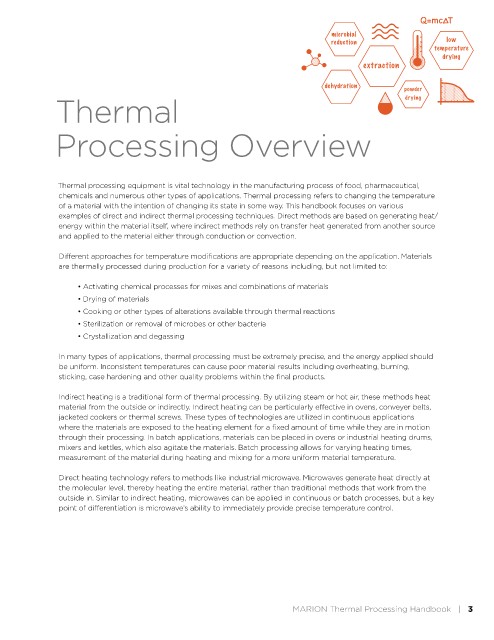Page 2705 - Flipbook_SolidDesignSoutheast2020
P. 2705
microbial
reduction low
temperature
drying
extraction
dehydration
powder
Thermal
drying
Processing Overview
Thermal processing equipment is vital technology in the manufacturing process of food, pharmaceutical,
chemicals and numerous other types of applications. Thermal processing refers to changing the temperature
of a material with the intention of changing its state in some way. This handbook focuses on various
examples of direct and indirect thermal processing techniques. Direct methods are based on generating heat/
energy within the material itself, where indirect methods rely on transfer heat generated from another source
and applied to the material either through conduction or convection.
Different approaches for temperature modifications are appropriate depending on the application. Materials
are thermally processed during production for a variety of reasons including, but not limited to:
• Activating chemical processes for mixes and combinations of materials
• Drying of materials
• Cooking or other types of alterations available through thermal reactions
• Sterilization or removal of microbes or other bacteria
• Crystallization and degassing
In many types of applications, thermal processing must be extremely precise, and the energy applied should
be uniform. Inconsistent temperatures can cause poor material results including overheating, burning,
sticking, case hardening and other quality problems within the final products.
Indirect heating is a traditional form of thermal processing. By utilizing steam or hot air, these methods heat
material from the outside or indirectly. Indirect heating can be particularly effective in ovens, conveyer belts,
jacketed cookers or thermal screws. These types of technologies are utilized in continuous applications
where the materials are exposed to the heating element for a fixed amount of time while they are in motion
through their processing. In batch applications, materials can be placed in ovens or industrial heating drums,
mixers and kettles, which also agitate the materials. Batch processing allows for varying heating times,
measurement of the material during heating and mixing for a more uniform material temperature.
Direct heating technology refers to methods like industrial microwave. Microwaves generate heat directly at
the molecular level, thereby heating the entire material, rather than traditional methods that work from the
outside in. Similar to indirect heating, microwaves can be applied in continuous or batch processes, but a key
point of differentiation is microwave’s ability to immediately provide precise temperature control.
MARION Thermal Processing Handbook | 3
3
MARION T
hermal Pr
oc
sing Handbook |
es

